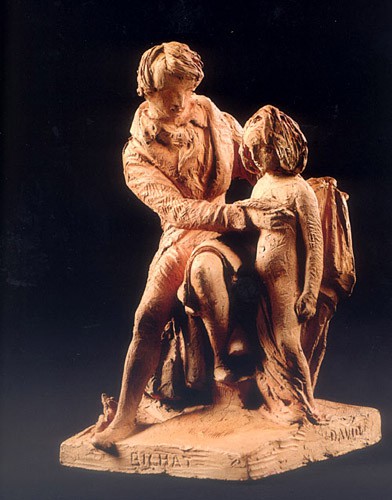As a son of the Enlightenment, Pierre-Jean David, also known as David d'Angers, was inspired by the idea of progress and accorded as much importance in his Panthéon relief to men of science as to statesmen or artists. Medicine underwent unprecedented development during the period, and David was fascinated by Ambroise Paré, one of the 'fathers of surgery', and Baron Larrey, Napoleon I's surgeon, to name merely the most famous. David dedicated medallions, busts and full-length statues to these pioneers, depending on their reputation and his own personal feelings towards the individual in question. Marie François Xavier Bichat is one of the rare examples who received two such dedications, as well as the inevitable medallion.
Bichat was born in 1771 in Thoirette, near to Bourg-en-Bresse, and was a professor at the Faculté de médecine in Paris as well as doctor at the Hôtel-Dieu hospital. His research into anatomy and physiology rapidly earned him recognition and fame. However, in 1802 he contracted tuberculosis during one of his experiments and died on 22 July of that year. His publications include Recherches physiologiques sur la vie et sur la mort (1799), Traité des membranes (1800), Anatomie générale (1801) and Anatomie descriptive (1801).
His work had an important influence on David's thinking and treatment of human anatomy and the phenomenon of death, with which he was obsessed. David was fascinated by the character of Bichat, and his first portrayal of the doctor was on the Panthéon relief, in the throes of death and close to Voltaire and Rousseau. David then put all his energy into convincing the councillors of the Ain département to entrust him with the creation of a monument to this glorious enfant du pays; his proposal was accepted in the summer of 1839.
In this preliminary statue, Bichat is depicted as a very young, almost adolescent, man. His rather dishevelled hair and loosened necktie are testament to the long hours he spent amongst the sick and dying. He pulls backs the blanket covering the child, whose eyes are consumed by a fever, with a tenderness that is all the more marked because it was Robert, the son of the sculptor, who posed for the work. Bichat's other hand holds a quill, with which he prepares to write down his observations in the notes that lie balanced on his thigh.
Talabardon et Gautier (tr. P.H.)
Extract from the exhibition catalogue “Le XIXe siècle”
December 2008
Preliminary statue of Bichat
Artist(s) : DAVID D'ANGERS Pierre-Jean

- Date :
- Between 1851-1856
- Technique :
- Fired clay
- Dimensions :
- H = 26.6 cm, L = 15.5 cm, P = 16.7 cm
- Place held :
- Galerie Talabardon et Gautier
- Photo credit :
- © Galerie Talabardon et Gautier

